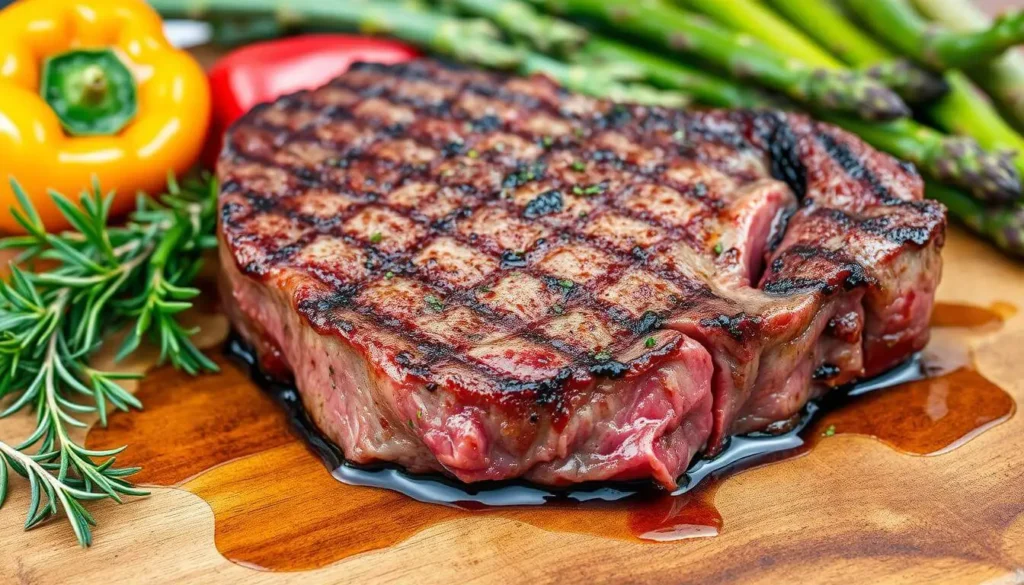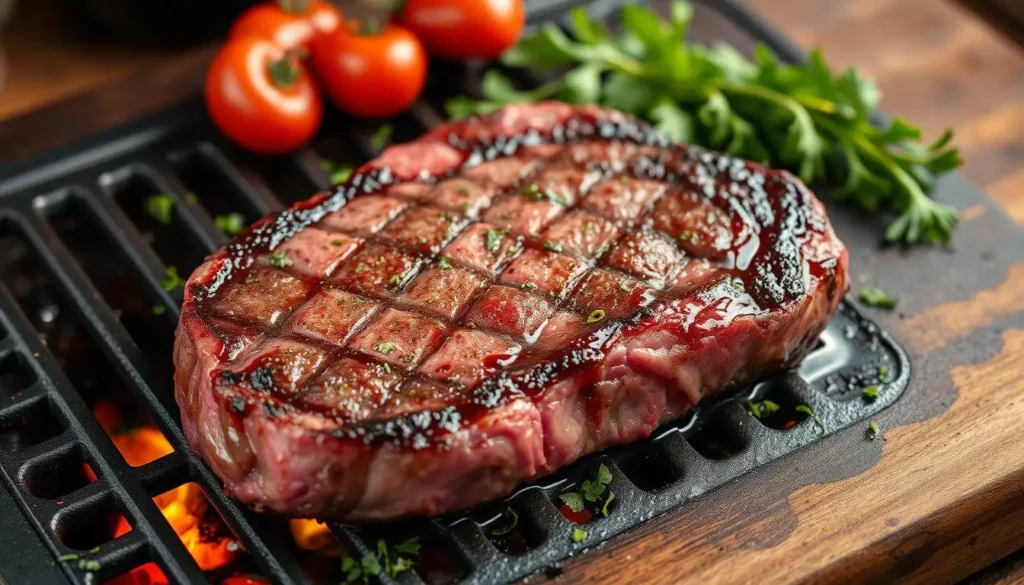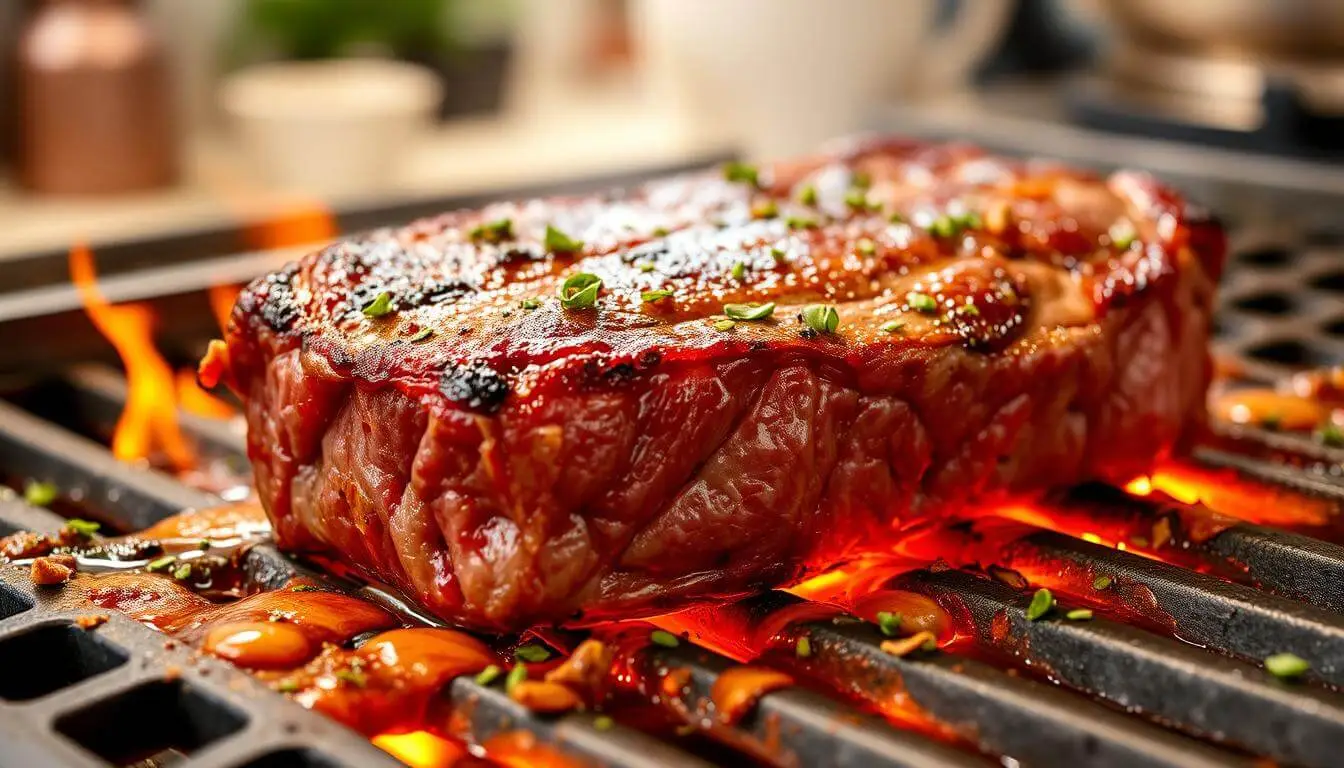Discover the rich flavor and tender texture of beef chuck eye steak. It’s a cut of meat that offers a unique mix of taste and value. You’ll learn about its anatomy, location, how to spot quality meat, and various cooking methods.
These methods include delicious chuck eye steak recipes. As you explore beef chuck eye steak, you’ll find it’s an often-overlooked gem. It can make your meals better. With the right techniques and recipes, you can unlock its full flavor and enjoy perfect dishes.
Table of Contents
Key Takeaways
- Beef chuck eye steak is a flavorful and tender cut of meat that offers great value.
- Learning about the anatomy and location of the chuck eye steak can help you appreciate its unique characteristics.
- Identifying quality meat is crucial to bringing out the full potential of beef chuck eye steak.
- Cooking methods and recipes, such as chuck eye steak recipes, can make a big difference in the final result.
- With the right techniques, you can unlock the full flavor of beef chuck eye steak and enjoy a satisfying meal.
- Exploring different recipes and cooking methods can help you find your favorite way to prepare beef chuck eye steak.
What Is Beef Chuck Eye Steak?
Beef chuck eye steak comes from the fifth rib, near the cow’s shoulder. It’s part of the chuck primal, which also includes chuck roast and ground beef. But, the chuck eye steak is special for its tenderness and flavor.
This steak is tender and has a rich beefy taste. It’s great for grilling, pan-searing, or oven roasting. Its marbling pattern adds to its flavor and texture.
Anatomy and Location on the Cow
The chuck primal is the first five ribs of the cow. The beef chuck eye steak is cut from the fifth rib. This location near the shoulder makes it tender and flavorful.
Being close to the ribcage means it has more marbling. This increases its taste and texture.
Relation to Other Chuck Cuts
The beef chuck eye steak is different from other chuck cuts like chuck roast or ground beef. It’s more tender and flavorful, making it a premium cut. Yet, it’s still more affordable than other steaks.

Unique Characteristics
The beef chuck eye steak has a unique marbling pattern and firm texture. These features make it perfect for various cooking methods. The marbling adds flavor and tenderness, while the firm texture ensures a satisfying bite.
Whether grilled, pan-seared, or oven roasted, the chuck steak’s quality and taste will impress.
| Cut of Meat | Location on the Cow | Tenderness | Flavor |
| Beef Chuck Eye Steak | Fifth rib, near the shoulder area | Tender | Rich beefy taste |
| Chuck Roast | First five ribs | Less tender | Hearty, beefy flavor |
| Ground Beef | Varying locations | Varying tenderness | Varying flavor |
The Hidden Gem of Budget-Friendly Steaks
Beef chuck eye steak is a great choice for those who want tasty and affordable steaks. You can find it at butcher shops or supermarkets. It comes in various sizes and cuts, making it perfect for any meal, big or small.
Beef chuck eye steak is also very affordable, often cheaper than ribeye or sirloin. This makes it ideal for budget-conscious cooks. You can use it in many cut up chuck eye steak recipes, from simple grilled steak to steak salads or sandwiches.
Here are some popular ways to prepare beef chuck eye steak:
- Grilling: This method enhances the steak’s natural flavors and adds a nice char.
- Pan-searing: It allows you to add flavors like garlic or herbs to the steak.
- Oven roasting: This method cooks the steak to the perfect doneness and adds extra flavor.

In summary, beef chuck eye steak is a hidden gem in the steak world. It’s affordable, flavorful, and tender. Its versatility in cut up chuck eye steak recipes lets you try different cooking methods and flavors. This makes it a great choice for anyone looking to spice up their meals.
Identifying Quality Chuck Eye Steak at the Butcher
When picking a beef chuck eye steak, aim for the best quality. A top-notch steak feels firm and looks rich red. Marbling, or fat streaks in the meat, is key for tenderness and taste.
For a tender chuck steak, seek out moderate marbling. It boosts flavor and makes the steak soft. The price of a chuck eye steak can change based on quality and size. Yet, it’s often cheaper than other steak cuts.
Visual Indicators of Good Quality
Good-quality beef chuck eye steak shows a deep red color and some marbling. It should also feel firm. When choosing a steak, remember these points:
- Seek a steak with balanced marbling and lean meat
- Look for a deep red color
- Consider the steak’s size and thickness for cooking and tenderness
Marbling Patterns to Look For
Marbling patterns differ by steak type and cattle breed. For a chuck eye steak, aim for moderate marbling. It improves flavor and tenderness.
Preparing Your Chuck Eye Steak for Cooking
To get the best taste and texture, prepare your chuck eye steak right. Trim off any extra fat and season with salt, pepper, and spices. Make sure the steak is at room temperature before cooking. You can also tenderize it by pounding it gently or using a tenderizer tool to make it chuck steak tender.
Here are some steps to prepare your steak:
- Trim excess fat to promote even cooking
- Season with salt, pepper, and other spices to enhance flavor
- Bring the steak to room temperature for optimal cooking results
These steps will help you get a delicious and tender chuck eye steak. Look for various beef chuck eye steak recipes online to try new seasoning and cooking methods.
By following these simple steps and trying different beef chuck eye steak recipes, you’ll enjoy a tasty and chuck steak tender dish. It’s sure to impress everyone.
Essential Seasoning Techniques for Maximum Flavor
Seasoning is key when making a tasty beef chuck eye steak. You can mix garlic, herbs, and spices for a unique taste. For cut up chuck eye steak recipes, try salt, pepper, and paprika for a smoky flavor.
To enhance your beef chuck eye steak, try marinades or rubs. They add moisture and flavor, making the steak tender. Here are some favorites:
- Italian-style marinade with olive oil, garlic, and herbs
- Spicy rub with chili powder, cumin, and brown sugar
- Asian-inspired marinade with soy sauce, ginger, and sesame oil
Make sure to apply marinades or rubs evenly. Let the steak sit for the recommended time. This lets the flavors soak in, making the steak tender. For cut up chuck eye steak recipes, adding lemon juice or vinegar helps too. It breaks down the meat and adds flavor.
By using these seasoning tips, you can make a flavorful beef chuck eye steak. Whether you choose a marinade, rub, or simple seasonings, the goal is to experiment. Find the flavors that you enjoy the most.
Cooking Methods for the Perfect Chuck Eye Steak
There are many ways to cook a beef chuck eye steak for a tasty and tender dish. Choosing the right cooking method is key to a chuck steak tender.
Some popular cooking methods for beef chuck eye steak include:
- Grilling: adds a smoky flavor and a nice char to the steak
- Pan-searing: allows you to achieve a crispy crust on the steak while keeping the interior tender and juicy
- Oven roasting: provides a consistent heat and can help to cook the steak evenly throughout
It’s important to cook your beef chuck eye steak to the right temperature. This ensures it’s both safe to eat and tender. A chuck steak tender comes from proper cooking and handling.
Cooking a perfect beef chuck eye steak needs attention and practice. With the right method and technique, you’ll enjoy a delicious and chuck steak tender meal.
Temperature Guidelines and Doneness Levels
When cooking a chuck steak tender, getting the perfect doneness is key. To make your beef chuck eye steak recipes tasty, knowing the internal temperature is important. For medium-rare, aim for 130°F. Medium is 140°F, and medium-well is 150°F. If you like your steak well-done, it should hit 160°F.
To check if your steak is done, a meat thermometer is the best tool. You can also use the finger test, but it’s less precise. Remember, the right temperature can change based on the steak’s thickness and your taste.
Rare to Well-Done Guidelines
- Rare: 120°F – 130°F
- Medium-rare: 130°F – 135°F
- Medium: 140°F – 145°F
- Medium-well: 150°F – 155°F
- Well-done: 160°F – 170°F
By sticking to these temperature guidelines, you’ll get your chuck steak tender just right. This will make your beef chuck eye steak recipes a hit. Always use a meat thermometer for the best results and to keep your food safe.
Common Cooking Mistakes to Avoid
When cooking a beef chuck eye steak, it’s key to steer clear of common errors. These can make the steak tough and dry. One big mistake is overcooking. You can dodge this by using a meat thermometer to check the steak’s internal temperature.
Another error is underseasoning, leading to a bland steak. To prevent this, try marinades or rubs to add flavor to your cut up chuck eye steak recipes.
Here are some common cooking mistakes to avoid when cooking a beef chuck eye steak:
- Overcooking: Cook the steak to the recommended internal temperature to avoid overcooking.
- Underseasoning: Use different seasoning techniques to add flavor to your steak.
- Pressing down on the steak: Avoid pressing down on the steak with your spatula while it’s cooking, as this can squeeze out the juices and make the steak tough.
By avoiding these common cooking mistakes, you can ensure that your beef chuck eye steak is cooked to perfection and full of flavor. Try experimenting with different cut up chuck eye steak recipes to find your favorite way to cook this delicious steak.
Serving Suggestions and Complementary Sides
When serving your beef chuck eye steak, think about sides that bring out its flavor. A simple salad with a light vinaigrette is a great choice. It offers a refreshing contrast to the steak’s bold taste.
For a heartier meal, pair the chuck steak with roasted veggies like asparagus or Brussels sprouts. These add flavor and make the meal more nutritious. Other good options include:
- Garlic mashed potatoes
- Grilled or sautéed mushrooms
- Roasted sweet potatoes
For drinks, a bold red wine like Cabernet Sauvignon or Syrah goes well with the steak. A rich, full-bodied beer is also a good choice.
The secret to a great beef chuck eye steak is balancing its flavor with the right sides and drinks. By trying these suggestions, you’ll make a memorable meal.
| Side Dish | Wine Pairing |
| Roasted Vegetables | Cabernet Sauvignon |
| Garlic Mashed Potatoes | Merlot |
| Grilled Mushrooms | Syrah |
Storage and Leftover Management
After cooking your beef chuck eye steak, it’s key to store it right. This keeps its taste and texture fresh. You can keep the steak in a sealed container in the fridge for up to three days. When you reheat it, use low heat and don’t overcook. This helps the chuck steak tender stay soft and juicy.
There are lots of ways to use leftover chuck eye steak in beef chuck eye steak recipes. You can make a steak salad, sandwich, or stir-fry. Here are some ideas to get you started:
- Steak salad: Slice the leftover steak and serve it on top of a bed of mixed greens with your favorite toppings.
- Steak sandwich: Thinly slice the leftover steak and serve it on a crusty bread with your favorite condiments.
- Stir-fry: Slice the leftover steak and stir-fry it with your favorite vegetables and sauces.
Always handle and store your leftover steak safely to avoid foodborne illness. By following these tips, you can enjoy your delicious beef chuck eye steak recipes for days to come.
Conclusion
Beef chuck eye steak is a hidden gem. It offers a great mix of flavor and affordability. By following the tips in this article, you can make amazing meals that everyone will love.
When cooking your chuck steak tender, pay close attention. The right seasoning and temperature control are key. With the right sides, this affordable steak becomes a culinary delight.
The beef chuck eye steak is great because it’s affordable yet delicious. Next time you’re at the butcher, try it out. A little care and creativity can make your dishes unforgettable.
FAQ
What is Beef Chuck Eye Steak?
Beef Chuck Eye Steak comes from the cow’s shoulder area, near the fifth rib. It’s part of the chuck primal, like chuck roast and ground beef. Known for its tender texture and rich flavor, it’s a great choice for grilling or pan-searing.
How does Beef Chuck Eye Steak compare to other steak cuts?
Beef Chuck Eye Steak is more affordable than ribeye or sirloin. It’s tender and flavorful, making it perfect for grilling or oven roasting.
How can I identify quality Beef Chuck Eye Steak at the butcher?
Look for a firm texture, rich red color, and moderate marbling. Marbling adds tenderness and flavor. It’s also more affordable than other cuts.
How should I prepare my Beef Chuck Eye Steak for cooking?
Trim excess fat and season with salt, pepper, and spices. Tenderize it with a meat mallet or tenderizer. Let it come to room temperature for even cooking.
What are some essential seasoning techniques for Beef Chuck Eye Steak?
Use garlic, herbs, and spices to enhance flavor. Marinades and rubs add moisture and taste. Season evenly and let it sit as recommended.
What are the best cooking methods for Beef Chuck Eye Steak?
Grilling, pan-searing, and oven roasting are great options. Each method highlights the steak’s flavor and texture. Use a meat thermometer for the right doneness.
How can I avoid common cooking mistakes with Beef Chuck Eye Steak?
Avoid overcooking to prevent toughness. Don’t press down on the steak while cooking. Also, don’t under-season, as it can be bland.
What are some serving suggestions and complementary sides for Beef Chuck Eye Steak?
Pair it with a simple salad and light vinaigrette for a refreshing contrast. Roasted vegetables like asparagus or Brussels sprouts are also great. A bold red wine, like Cabernet Sauvignon, complements the steak’s flavor.
How should I store and manage leftover Beef Chuck Eye Steak?
Store leftovers in an airtight container in the fridge for up to three days. Reheat low and slow to preserve flavor and texture. Use leftovers in salads, sandwiches, or stir-fries.

